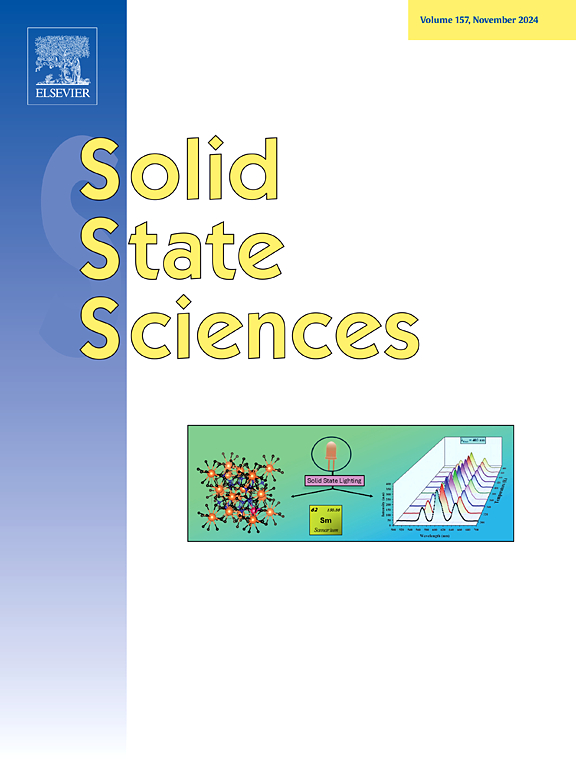Experimental and DFT characterization of argyrodite type Ag8SiS6 multidispersed powders and ceramics
IF 3.4
3区 化学
Q2 CHEMISTRY, INORGANIC & NUCLEAR
引用次数: 0
Abstract
Herein we present a detailed study of silver-based argyrodite Ag8SiS6 in the form of micro- and nanopowders and corresponding ceramics. The microcrystalline fraction has a particle size of 10–20 μm. The average particle size of nanopowders, as determined by SEM, are ∼140 nm (30 min of grinding) and ∼115 nm (60 min of grinding). XRD analysis confirms the formation of orthorhombic low temperature modification of Ag8SiS6 and the absence of degradation during the ball milling process. The nature of the optical transition and the change in the Eg with dispersion were determined by combining DFT calculations and diffuse reflectance spectroscopy. The microstructural analysis of ceramics indicates a presence of quite homogeneous ceramics (with an average crystallite size of ∼0.41 μm, ∼0.37 μm and ∼0.34 μm) and uniformly distributed microvoids. The compositional homogeneity of the ceramics was established by EDS. The electrical conductivity and activation energy of the studied ceramics were characterized by the impedance spectroscopy. The Ag8SiS6 ceramics are characterized by increase of ionic conductivity (up to 1.1 × 10−4 S/cm) and a decrease in its activation energy (to 0.234 eV) with decreasing of average crystallite sizes in ceramics. The influence of the recrystallization process and grain size on the electrical parameters of Ag8SiS6 ceramics is discussed.

银晶型Ag8SiS6多分散粉体与陶瓷的实验与DFT表征
本文详细研究了银基银辉石Ag8SiS6的微粉和纳米粉以及相应的陶瓷。微晶组分的粒径为10 ~ 20 μm。扫描电镜测定的纳米粉体的平均粒径为~ 140 nm(研磨30 min)和~ 115 nm(研磨60 min)。XRD分析证实了Ag8SiS6在球磨过程中形成了正交低温改性,没有发生降解。结合DFT计算和漫反射光谱分析确定了光跃迁的性质和Eg随色散的变化。陶瓷的显微结构分析表明,陶瓷具有均匀性(平均晶粒尺寸为~ 0.41 μm, ~ 0.37 μm和~ 0.34 μm)和均匀分布的微孔。通过能谱分析确定了陶瓷的成分均匀性。用阻抗谱法对陶瓷的电导率和活化能进行了表征。Ag8SiS6陶瓷的特点是,随着陶瓷中平均晶粒尺寸的减小,离子电导率增加(高达1.1 × 10−4 S/cm),活化能降低(0.234 eV)。讨论了再结晶工艺和晶粒尺寸对Ag8SiS6陶瓷电学参数的影响。
本文章由计算机程序翻译,如有差异,请以英文原文为准。
求助全文
约1分钟内获得全文
求助全文
来源期刊

Solid State Sciences
化学-无机化学与核化学
CiteScore
6.60
自引率
2.90%
发文量
214
审稿时长
27 days
期刊介绍:
Solid State Sciences is the journal for researchers from the broad solid state chemistry and physics community. It publishes key articles on all aspects of solid state synthesis, structure-property relationships, theory and functionalities, in relation with experiments.
Key topics for stand-alone papers and special issues:
-Novel ways of synthesis, inorganic functional materials, including porous and glassy materials, hybrid organic-inorganic compounds and nanomaterials
-Physical properties, emphasizing but not limited to the electrical, magnetical and optical features
-Materials related to information technology and energy and environmental sciences.
The journal publishes feature articles from experts in the field upon invitation.
Solid State Sciences - your gateway to energy-related materials.
 求助内容:
求助内容: 应助结果提醒方式:
应助结果提醒方式:


